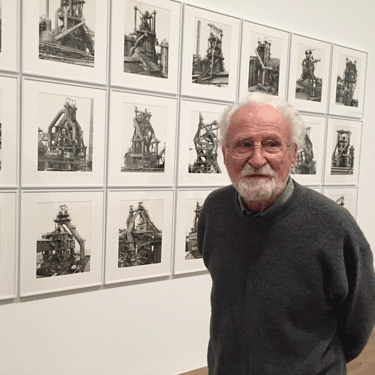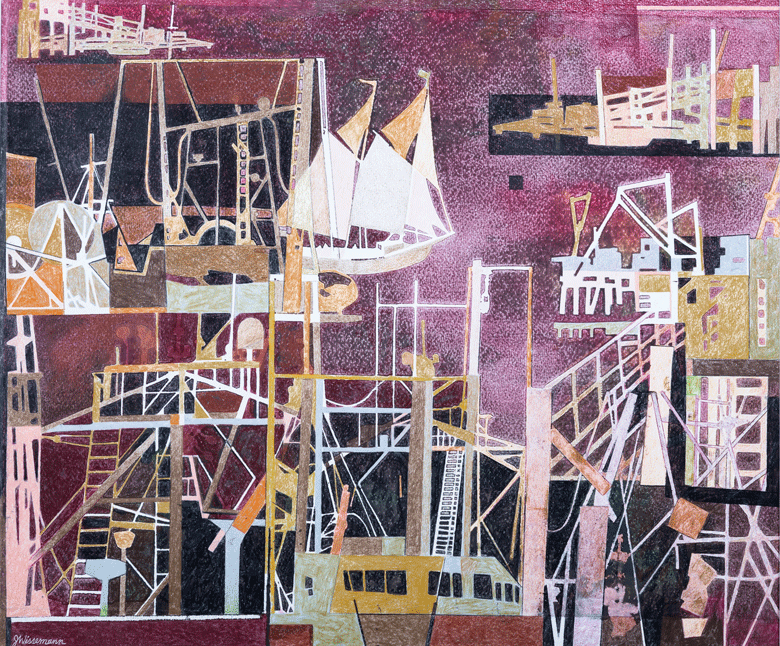In a scene in Jeffrey Mathias’s 2014 video “John Wissemann: Stencils & Pencils & Working Harbors of Maine,” the artist visits Friendship Harbor with fellow painter Sam Cady who lives in the neighborhood.
As they admire the configurations of sheds, docks, and boats, Cady notes that Friendship has made “a real point” of maintaining a working waterfront, with few fancy shops and limited services for cruising boats. Such a place, he says, is “fairly rare these days.”
As they talk, Wissemann points to a section of the waterfront and declares, “There’s ten or 20 compositions right there.”
He shares his love of the prospect, declaring it his “favorite working spot,” with all the shapes and colors he wants to use “right here.” He wonders at how everything constantly changes and never stops fascinating him.
Over the years, he often turned to art history for inspiration, including large-format colored pencil drawings based on Japanese woodblock prints…
Wissemann’s “Friendship Harbor 2013” exemplifies his complex renderings of Maine waterfronts. Using a labor-intensive process that includes printmaking, stenciling, and colored pencils, he represents by dynamic means the assemblage of wharves, ladders, ropes, ramps, and other elements of the marine scene, topping it off, as it were, with a sailboat crossing the water.
Friendship Harbor was among the first waterfronts to entice Wissemann after he and his wife, painter Nancy Wissemann-Widrig, started coming to Maine in the 1960s (she was a friend of Helen Langlais and her husband, sculptor Bernard Langlais).

They eventually settled in Cushing, near the Langlaises, for seasonal stretches. Over the years he explored other shorefront sites, including Rockland, Belfast, Bath, Boothbay Harbor, Port Clyde, and Portland.
That fascination with the waterfront began early in his life. Wissemann, who passed away last year at age 97, grew up in Southold, N.Y, on the North Fork of Long Island. In nearby Greenport Harbor he found subjects for some of his earliest paintings. Following his service in the U.S. Navy from 1943 to 1946, he went on to earn a BA and MFA from Syracuse University, committing himself to a life in art.
Wissemann’s artistic endeavors went hand in hand with his career as an art teacher. He taught at the Southold Union Free School from 1953 to 1986 and was adjunct professor at Southampton College where he taught watercolor painting.
Wissemann worked in series, latching onto an idea/concept/subject and pursuing it with rigor and inventiveness. Over the years, he often turned to art history for inspiration, including large-format colored pencil drawings based on Japanese woodblock prints which caused a sensation when they were shown at the Farnsworth Museum in 2001.
Writing about the exhibition in the Maine Sunday Telegram critic Philip Isaacson referred to the effect of the work as “incendiary.”
When Frances Hodsdon (1926-2022) invited Wissemann to use the printing press at the Round Top Center for the Arts in Damariscotta, he added printmaking to his artistic repertoire. Monotype became a go-to format.
In 2014 the Gold/Smith Gallery presented “The Working Waterfront,” an exhibition of Wissemann’s improvised renderings of various Maine harbors. Writing about the show, Karen Vander compared the artist to “the conductor of a jazz ensemble, improvising the variations to change the mood, tonality, atmosphere, and emotion of each piece.”
The following year the Maine Maritime Museum in Bath hosted “In Sight: Prints by John Wissemann of BIW and Bath’s Working Waterfront.” His colored pencil on monoprint views of Bath Iron Works from the Sagadahoc Bridge encompass the complexity of the shipyard: cranes, derricks, stanchions, and the like.
Wissemann’s 2020 exhibition at Caldbeck Gallery offered stunning floral images inspired by the garden of a neighbor, the famed horticultural writer and author Leslie Land (1947-2013). The pieces are “equal parts homage, reflection, and exploration,” the artist noted.
For his last solo show at Caldbeck, in 2022, Wissemann revealed a new vein of abstraction, presenting brilliant crazy quilt-like compositions made from stencils, spray paint, and watercolor. The work underscores something his longtime friend and dealer John Vander expressed in the aforementioned video: the amazing way the artist managed to combine technical precision with “a kind of spiritual openness.”
Wissemann is represented by the Caldbeck Gallery in Rockland and Gold/Smith Gallery in Boothbay Harbor. One of his pieces will be featured in a show honoring photographer Peggy McKenna at Waterfall Arts in Belfast this coming summer.





